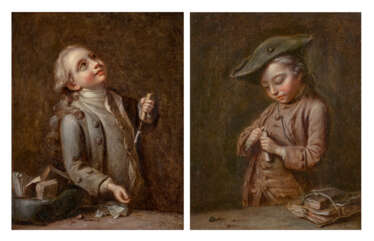портрет детей


Pablo Ruiz Picasso, a Spanish artist renowned for his revolutionary contributions to the 20th-century art scene, is a figure that resonates profoundly with collectors and art experts. His unique blend of talents in painting, sculpture, printmaking, and ceramic art, infused with his time in France, positioned him as a pivotal character in modern art history.
Picasso's artistic journey was marked by distinct periods, each showcasing his evolving style and genius. His early years were characterized by the Blue Period (1901-1904), followed by the Rose Period (1904-1906), and then the African-influenced Period (1907-1909). Picasso's name is synonymous with Cubism, a movement he co-founded, which significantly altered artistic perspectives and methods. Works like "Les Demoiselles d'Avignon" (1907) and "Guernica" (1937) are emblematic of his cubist legacy, the latter being a poignant anti-war statement that remains influential.
His later years saw a return to more traditional styles, with neoclassical and surrealist influences becoming evident. Works from these phases reflect a deep engagement with mythological themes, as seen in "Faun with Stars" (1955), symbolizing his late-life romance with Jacqueline Roque, his second wife.
Picasso's prolific output and innovative spirit made him a legend in his own time, a status that only grew after his death. His works, housed in major museums and private collections worldwide, continue to captivate and inspire.
As a collector or expert in art and antiques, staying informed about Picasso's works, their auction events, and sales is essential. To stay updated on the latest developments and opportunities related to Pablo Picasso, sign up for our specialized updates. Rest assured, this subscription will focus solely on new product sales and auction events pertaining to Picasso's art, ensuring that you receive only the most relevant and valuable information.


Aleksei Alekseevich Kharlamov (russian: Алексей Алексеевич Харламов) was a Russian artist renowned for his portrait paintings. Born in 1840 in Saratov, Russia, Kharlamov displayed artistic talent from an early age, eventually studying under the guidance of Professor A. T. Markov at the Imperial Academy of Arts. His dedication to art was rewarded with several medals during his academic years, and his piece titled "Baptism of Kiev" earned him a prestigious gold medal in 1866.
Kharlamov spent much of his career in Paris, where he was deeply influenced by Western European artistic movements. His works often featured delicate and finely detailed representations of women and children, capturing the subtleties of expression and mood which became his signature style. Notably, his painting "Young Woman and Child" from 1894 showcases his adept use of light and texture to portray serene domestic scenes, a piece that is currently held in the Bowdoin College Museum of Art.
Throughout his career, Kharlamov was associated with prominent cultural figures such as the novelist Ivan Turgenev, and he participated actively in the Parisian art scene. His portraits were highly sought after, with clients paying substantial sums for his works, reflecting his status as a distinguished portraitist of his time.
For those interested in exploring the works of Aleksei Alekseevich Kharlamov and the rich cultural tapestry of his era, signing up for updates on auctions and events featuring his art can provide valuable insights and opportunities to acquire pieces by this notable artist. Stay informed about the latest sales and exhibitions by subscribing to our newsletter dedicated to Kharlamov’s legacy.


Lavinia Fontana was a Bolognese Mannerist painter active in Bologna and Rome. She is best known for her successful portraiture, but also worked in the genres of mythology and religious painting. She was trained by her father Prospero Fontana who was a teacher at the School of Bologna. She is regarded as the first female career artist in Western Europe as she relied on commissions for her income. Her family relied on her career as a painter, and her husband served as her agent and raised their 11 children. She was perhaps the first woman artist to paint female nudes, but this is a topic of controversy among art historians.


John Everett Millais was an influential British artist and a key figure in the Pre-Raphaelite Brotherhood, celebrated for his detailed and naturalistic paintings. Born in Southampton in 1829, Millais was a child prodigy, gaining admission to the Royal Academy Schools at the remarkable age of eleven. His early work, characterized by meticulous attention to detail and vibrant naturalism, stirred controversy and admiration alike. One of his most renowned pieces, "Ophelia" (1851-52), exemplifies his style during this period, capturing intricate natural scenes with profound emotional depth.
Millais's personal life was as notable as his artistic career, particularly his marriage to Effie Gray, who was previously married to the art critic John Ruskin. This union, following Effie's annulment from Ruskin, produced eight children and intertwined with Millais's evolving artistic journey.
Later in his career, Millais's style transitioned towards a broader approach, a change criticized by some contemporaries but which also garnered him significant acclaim and financial success. His influence extended to various artists, including John Singer Sargent, and his works remain pivotal in the study of Victorian art. His dedication to his craft earned him numerous honors, including a baronetcy, making him the first artist to be bestowed such an honor.
Millais's legacy is preserved in numerous galleries worldwide, with Tate Britain and the Ashmolean Museum housing key works like "The Order of Release" and "The Return of the Dove to the Ark." His contribution to art and culture remains significant, offering a window into the Victorian era's aesthetic and social dynamics.
For enthusiasts and collectors interested in Millais's work, staying updated on exhibitions and sales can provide invaluable insights into his artistry and its enduring appeal. Subscribing to updates on Millais can ensure you remain informed about upcoming events and opportunities related to this seminal artist.


Harold Knight was an English portrait, genre and landscape painter.


James Peale was an American painter, best known for his miniature and still life paintings.


John Brewster was a prolific, Deaf itinerant painter who produced many charming portraits of well-off New England families, especially their children. He lived much of the latter half of his life in Buxton, Maine, USA, recording the faces of much of Maine's elite society of his time.
According to the website of the Fenimore Art Museum in Cooperstown, New York, "Brewster was not an artist who incidentally was Deaf but rather a Deaf artist, one in a long tradition that owes many of its features and achievements to the fact that Deaf people are, as scholars have noted, visual people."


Pierre-Auguste Renoir was a French artist, celebrated as a pivotal figure in the development of the Impressionist movement. Born in Limoges, France, in 1841, Renoir's early experiences in Paris and his apprenticeship as a porcelain painter laid the foundation for his illustrious career in art. His transition to painting was marked by an early fascination with the play of light and color, which became a hallmark of his work. Renoir's paintings are renowned for their vibrant light and saturated color, often focusing on people in intimate and candid compositions. This focus on beauty and a particular affinity for capturing the sensuality of the female form distinguished his work from his contemporaries.
Renoir's contributions to Impressionism were significant, characterized by his use of bright colors and a technique that captured the movement and luminosity of the scene. His evolution as an artist saw him experimenting with a more linear and classical style, especially after his travels to Italy, where he was deeply influenced by the Renaissance masters. Despite facing personal challenges, including severe rheumatoid arthritis in his later years, Renoir's passion for painting never waned. His determination saw him adapting his painting technique to his physical limitations, ensuring that his creative output remained prolific until his death in 1919.
Among Renoir's notable works are "Bal du moulin de la Galette" (1876), "Luncheon of the Boating Party" (1880), and "Girls at the Piano" (1892). These masterpieces exemplify the essence of Impressionist art with their depiction of light, movement, and everyday life. Renoir's works are housed in prestigious museums around the world, serving as a testament to his enduring legacy in the realm of art.
For art collectors and experts, Renoir's oeuvre represents an essential segment of the Impressionist movement, offering insights into the evolution of modern art. His mastery in portraying the beauty of the moment and the depth of human emotion continues to captivate and inspire audiences worldwide.
If you are passionate about collecting or studying the works of Pierre-Auguste Renoir, we invite you to sign up for updates on new product sales and auction events related to this iconic artist. Stay informed about the opportunity to own a piece of art history and deepen your appreciation for the rich tapestry of culture and art that Renoir helped weave.


Pierre-Alfred Dedreux, who signed his works as Alfred de Dreux was a French portrait and animal painter, best known for his scenes with horses.


Adolphe Joseph Thomas Monticelli was a French painter of the generation preceding the Impressionists.




![Рудаков, К.И. Каталог выставки / [Вступ. статья З. Фомичевой]; Музей Акад. художеств СССР. [Сост. каталога Т.А. Петрова].](/assets/image/picture_1793921/90419/yeebfzvllmudnezwfecslkquhvcijkxkhmkvdi-pcfjffbmacrjbx07qms2ao0o81635933839jpg__fix_374_244.jpeg)
![Рудаков, К.И. Каталог выставки / [Вступ. статья З. Фомичевой]; Музей Акад. художеств СССР. [Сост. каталога Т.А. Петрова].](https://veryimportantlot.com/assets/image/picture_1793921/90419/yeebfzvllmudnezwfecslkquhvcijkxkhmkvdi-pcfjffbmacrjbx07qms2ao0o81635933839jpg__fix_374_244.jpeg)

































































